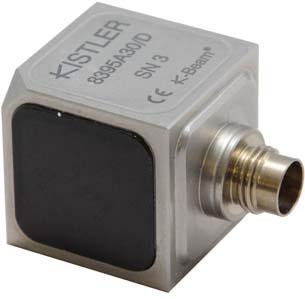Kistler Introduces Triaxial K-Beam MEMS Capacitive Accelerometer Family
Type 8395A accelerometer series designed for vehicle dynamics, structural analysis and NVH.
Latest News
November 22, 2010
By DE Editors
 |
Kistler North America has announced the launch of the Type 8395A, a miniature, cube-shaped, high-sensitivity, low-noise triaxial MEMS capacitive accelerometer series, incorporating Kistler’s own K-Beam technology. The Type 8395A is designed to simultaneously measure acceleration and low-frequency vibration in three mutually perpendicular axes (x, y and z) within a variety of automotive, aerospace, OEM, R&D and general laboratory test applications.
The Kistler Type 8395A series is available in six different models, with measurement ranges from ±2 g to ±200 g and a frequency response of 0 to 1000 Hz (5%). The compact design provides a 0.85-in. (21.6 mm) cube footprint and incorporates a MEMS variable capacitance sensing element, consisting of a small inertial mass and flexure element sandwiched between two parallel plates. As the mass deflects under acceleration, the capacitance between the element and plates changes, which is converted to a proportional voltage by the internal analog signal conditioner.
The output signal format of the Type 8395A series is bipolar at 0±4 V and provides a high-sensitivity, low-noise signal, which is compatible with a variety of data acquisition or readout devices. The accelerometer is shock rated to 6,000 g pk. Sensing elements and integral electronics are housed within a lightweight, welded titanium housing with a miniature circular 9-pin connector.
The Kistler Type 8395A triaxial capacitive MEMS accelerometer series offers an operating temperature range of -65°F to 250°F (-55°C to +125°C). It is powered by a single wide range supply between +6 and +50 VDC and has an internal voltage regulator. In the event that external temperature compensation is desired, a temperature output is provided, in addition to the output signals.
For more information, visit Kistler.
Sources: Press materials received from the company and additional information gleaned from the company’s website.
Subscribe to our FREE magazine, FREE email newsletters or both!
Latest News
About the Author
DE’s editors contribute news and new product announcements to Digital Engineering.
Press releases may be sent to them via [email protected].






